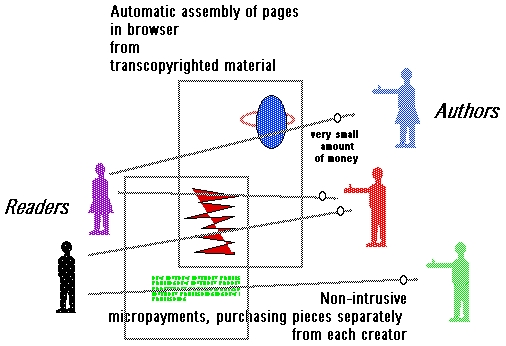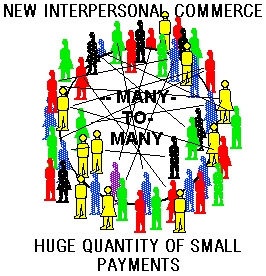trance
( d3
.html
98.10.14
To Ted Nelson Home
Page
Imagine being able to quote parts or
all of any
new book, recording or movie
on your Web page--
free, and without annoying the copyright
holder.
This is the promise of transcopyright.
Transcopyright and the
Possibility of a Transpublishing World
We can republish by indirection on the Web, telling the browser to get
a piece somewhere else. Right now, with no difficulty, you may put
in a pointer-- an IMG tag-- which brings in a .gif or .jpg picture from
publicly available page on the Internet.
The main reason we don't do this is that we don't have permission.
This kind of indirect publishing, also called "transpublishing" and
"inclusion by reference", may be way to clean up the copyright problem.
Other people have treated re-use of copyrighted material as something
to be prevented. The transcopyright approach treats it as
something to be guided and appropriately channeled, for everyone's benefit.

The key is this: the republished piece is always downloaded from the
original publisher's server. That way, if there is a charge for the
material, it is always paid to the original publisher.
The permission doctrine of transcopyright
is a central aspect of this. It's a way of cleanly giving permission
for someone to re-publish material indirectly.
The parts needed are:
-
A legal method for permitting transpublishing, or republication by reference.
The transcopyright permission method accomplishes
this purpose: the rightsholder places a permission statement on line (see
sample permission
statement).
-
A standardized tag which will bring in an arbitrary portion of participating
text from the net. We have proposed this as a net RFC (by Andrew
Pam).
-
A server that will deliver, or sell, minute portions of text ordered by
a browser on the basis of such a tag. We have prototyped this and
are working on a more robust version. The prototype also simulates
the resulting page..
-
A payment system that will invisibly purchase and assemble the quoted portions
of a compound document. The user can set a payment threshold below
which a click means an automatic purchase. We have prototyped such
a system (HyperCoin(tm)). Unlike other payment systems, HyperCoin
may be applied to materials already in place, and is designed for many-to-many
micropayment-- so that any account-holder may be both a buyer and a seller.
 These capabilities, taken together, can make possible universal transpublication--
always a principal goal of the Xanadu(R) system.
These capabilities, taken together, can make possible universal transpublication--
always a principal goal of the Xanadu(R) system.